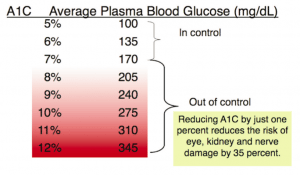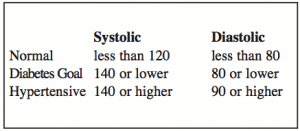ABCs of Diabetes Management
To celebrate the release of the fantastic 12 Lessons of Diabetes Program, we bring you an excerpt -- The ABCs of Diabetes Management. This is a perfect way to guide your clients through the basics of the numbers associated with diabetes. After all, those charts and labels can get confusing, and its harder to set and stick to goals when a person doesn't understand what's happening. After you read through this sample, check out the other diabetes resources listed at the bottom of the post. And of course, for more diabetes education materials just like this, check out the Nutrition Education Store...
 A1C, also known as hemoglobin A1C, is a measure of your average blood sugar levels over 2-3 months.This test is conducted by your doctor and tells you how much sugar is attached to the outside of your red blood cells. The higher the number, the greater your risk of diabetes-related complications. These complications include heart, kidney, and eye diseases. Reducing A1C by just one percent (from 8% to 7%) reduces the risk of eye, kidney, and nerve damage by 35 percent (1,3). The American Diabetes Association recommends keeping A1C below 7% for most people. You should work with your physician to determine the best target for you.
A1C, also known as hemoglobin A1C, is a measure of your average blood sugar levels over 2-3 months.This test is conducted by your doctor and tells you how much sugar is attached to the outside of your red blood cells. The higher the number, the greater your risk of diabetes-related complications. These complications include heart, kidney, and eye diseases. Reducing A1C by just one percent (from 8% to 7%) reduces the risk of eye, kidney, and nerve damage by 35 percent (1,3). The American Diabetes Association recommends keeping A1C below 7% for most people. You should work with your physician to determine the best target for you.
 Blood pressure is the force of blood against artery walls.Blood pressure is recorded in two numbers: the top number (systolic pressure) is the force of blood as the heart beats. The bottom number (diastolic pressure) is the force of blood between heartbeats. When these numbers are high, your heart is working harder than it should. Check your blood pressure at every doctor's visit. Here is a chart to show blood pressure. The American Diabetes Association has set 140/80 as the target for persons with diabetes.
Blood pressure is the force of blood against artery walls.Blood pressure is recorded in two numbers: the top number (systolic pressure) is the force of blood as the heart beats. The bottom number (diastolic pressure) is the force of blood between heartbeats. When these numbers are high, your heart is working harder than it should. Check your blood pressure at every doctor's visit. Here is a chart to show blood pressure. The American Diabetes Association has set 140/80 as the target for persons with diabetes. Cholesterol levels are indicators of heart health.High levels of LDL (aka "bad") cholesterol can clog and block arteries, and low levels of HDL (“good”) cholesterol can inhibit the removal of LDL cholesterol. Check your cholesterol levels at least once per year. You want to have as much HDL cholesterol as possible. Men should have over 40 and women should have over 50. You want to have as little LDL cholesterol as possible. Keep your measurement below 100 mg/dL. References:
Cholesterol levels are indicators of heart health.High levels of LDL (aka "bad") cholesterol can clog and block arteries, and low levels of HDL (“good”) cholesterol can inhibit the removal of LDL cholesterol. Check your cholesterol levels at least once per year. You want to have as much HDL cholesterol as possible. Men should have over 40 and women should have over 50. You want to have as little LDL cholesterol as possible. Keep your measurement below 100 mg/dL. References:
- Diabetes Care. 1987:10:1-19.
- American Association of Clinical Endocrinologists.
- Lancet 1998;352:837-53.
- http://www.nhlbi.nih.gov/health/health-topics/topics/dash/
- www.nhlbi.nih.gov/guidelines/cholesterol/atp3xsum.pdf
More Diabetes Resources from NutritionEducationStore.com:
- Diet and Type II Diabetes
- Assessing and Reducing Diabetes Risk
- Diabetes 101
- Diabetes Trivia
- Eating with Diabetes
- Shop Smart with Diabetes
- How to Read a Nutrition Facts Label
- Diabetes and Carbohydrate Counting
- Enjoying the Holidays While Managing Diabetes
- Diabetes and Your Heart
- 6 Lessons of Diabetes Program
- 12 Lessons of Diabetes Program
